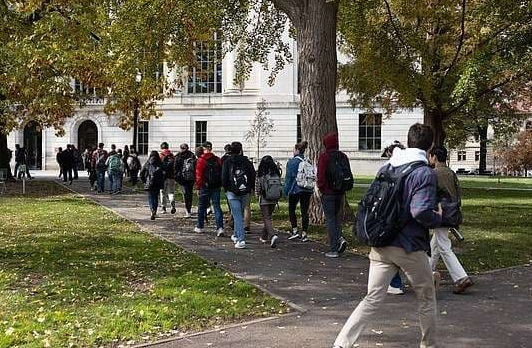
A top US public university in a deep-red state blows through $13 million a year on its huge diversity team, a shocking study shows.
Auditors say Ohio State University’s diversity, equity, and inclusion (DEI) team is so bloated, its salaries alone would cover tuition costs for 1,000 in-state students at the main campus in Columbus.
{snip}
OSU has queried how the $13 million figure was calculated, but did not dispute the sum and, when asked, did not offer an alternate estimate of its annual DEI spend.
DEI has become a battleground issue between progressives, who say it helps women and minorities get ahead in education, and conservatives, who say it amounts to reverse discrimination against white men.
President-elect Donald Trump has vowed to make America’s colleges ‘sane and affordable’ in a major overhaul of the Department of Education that would involve sacking ‘all Marxist diversity, equity, and inclusion bureaucrats.’
John Hart, CEO of OpenTheBooks.com, said he was stunned by OSU’s oversize DEI budget in a state where Trump, a Republican, won by a thumping 11 percentage points in November.
{snip}
‘The identity politics agenda is totally out of step with states like Ohio, yet it has enjoyed lavish financing at a flagship university.’
Researchers counted 201 employees with DEI-related roles in 2023 — 132 of them in the main offices of ‘Diversity and Inclusion’ and ‘Institutional Equity,’ and the rest spread out throughout the institution.
They included the 26 scholars working in the area of women’s gender and sexuality studies, including the professors Shannon Winnubst and Treva Lindsey, who both earn more than $150,000 a year.
Courses in that department now include ‘Sexualities and Citizenship, which covers the ‘contemporary lesbian experience’ and the bizarrely named ‘Queer Ecologies: Gender, Sexuality, & the Environment.’
{snip}
It’s not the first time that OSU has been targeted for DEI bloat — vice president-elect JD Vance, an OSU graduate, in 2023 wrote to officials and took to social media to decry the ‘troubling rise of racial prejudice on campus.’
‘If universities keep pushing racial hatred, euphemistically called DEI, we need to look at their funding,’ he posted.
He called DEI a ‘modern gloss on racism, anti-Semitism, and other ancient prejudices’ and called it a ‘rot’ that ‘is pervasive at Ohio State.’
That same year, an investigation by Do No Harm, a conservative medical group, found that OSU’s health sciences courses pushed students to tackle any ‘privileges’ they might have for being white, straight, or able-bodied.
This included course reading materials from the feminist activist and scholar Peggy McIntosh, about how white people are ‘subtly trained’ to mete out ‘hostility, distress, and violence … upon people of color.’
{snip}
‘Ohio State values diversity of thought, protects freedom of expression and works to foster a welcoming environment for Ohioans from every community in this state,’ said Johnson.
Much of the university’s DEI funding was spent on helping immigrants, people with disabilities or young children, and cash-strapped people from ‘rural Ohio and Appalachia’ get an education, he added.
Founded in 1870, OSU, with 65,000 students and 7,300 academic staff, is among America’s largest universities and in the ‘Big Ten’ athletic conference, which now has 18 members.
OSU and other public schools raise money from many sources, including tuition fees, endowments, and their sports teams, but also receive taxpayer money from federal, state and local sources.
OSU spends more on DEI than other public schools, but less than the University Of North Carolina, at about $90 million a year, and the roughly $20 million a year at the University of Virginia, according to Openthebooks.com.
The group has in the past faced criticism for ‘too broad’ a definition of what constitutes a DEI worker.
For some, DEI schemes are important and necessary, as they can help to overcome historical racism and sexism and make it easier for people of all backgrounds to get ahead in education and work.
Critics say it’s a form of reverse discrimination that unfairly blows back on straight, white men.
Others say DEI schemes may be well-intentioned, but seldom achieve their desired goals and often make things worse by stirring up divisions in lecture halls and offices.
{snip}
Across the country, conservative lawmakers have begun to target diversity programs in state agencies, schools and private companies.
At least 10 Republican-leaning states have cracked down on DEI in recent years: Alabama, Florida, Idaho, Indiana, North Carolina, North Dakota, Tennessee, Texas, Utah, and Wyoming.
Some of these policies ban state funds from being used for diversity-based programs, activities, and offices on college campuses, as seen in Alabama. Some states, like Texas, ban diversity offices at universities altogether.
Ohio’s state anti-DEI bill failed to clear the House in 2024, but its sponsor, state Rep. Jerry Cirino, says he’ll try again in 2025 and aim to end ‘inherently discriminatory’ policies in Ohio colleges.
Hart, from the OpenTheBooks.com, says he expects state lawmakers to take more action this year.
‘Even though it feels like the tide is turning against DEI, dismantling the DEI infrastructure will not be easy,’ he said.
‘The Trump administration will roll back these programs within the federal government, so in some ways we’re going to see the battleground move to the states. Dozens of governors and legislatures can use our findings to take action.’
* Original Article:
https://www.dailymail.co.uk/news/article-14247261/amp/ohio-state-university-public-college-red-state-dei-budget.html?ito=smartnews


